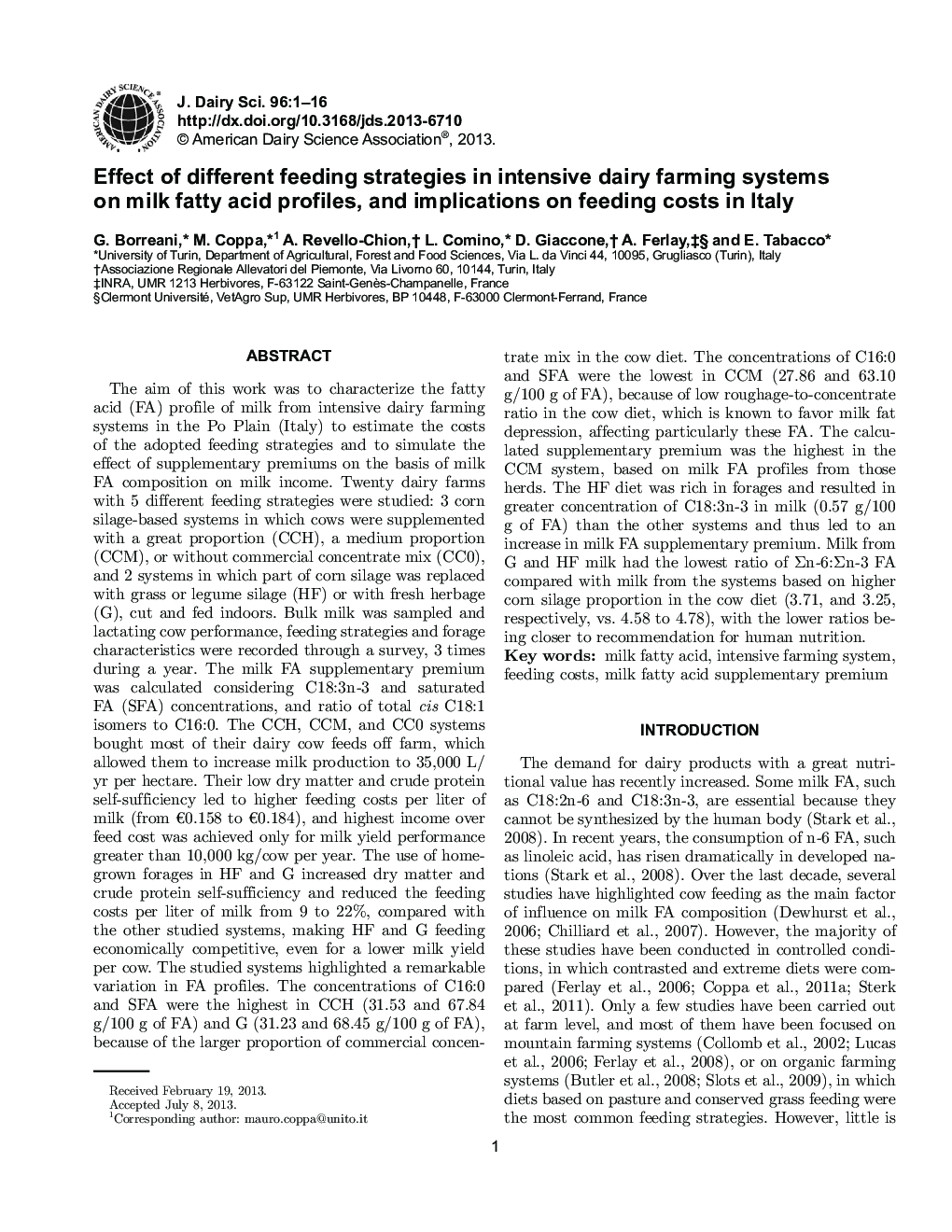| کد مقاله | کد نشریه | سال انتشار | مقاله انگلیسی | نسخه تمام متن |
|---|---|---|---|---|
| 10974986 | 1108030 | 2013 | 16 صفحه PDF | دانلود رایگان |
عنوان انگلیسی مقاله ISI
Effect of different feeding strategies in intensive dairy farming systems on milk fatty acid profiles, and implications on feeding costs in Italy
ترجمه فارسی عنوان
اثر استراتژی های تغذیه ای مختلف در سیستم های کشاورزی فشرده بر شاخص های اسید چرب شیر و پیامدهای آن در هزینه های تغذیه در ایتالیا
دانلود مقاله + سفارش ترجمه
دانلود مقاله ISI انگلیسی
رایگان برای ایرانیان
کلمات کلیدی
اسید چرب شیر سیستم کشاورزی فشرده، هزینه های تغذیه شیر چربی اضافی حق بیمه،
موضوعات مرتبط
علوم زیستی و بیوفناوری
علوم کشاورزی و بیولوژیک
علوم دامی و جانورشناسی
چکیده انگلیسی
The aim of this work was to characterize the fatty acid (FA) profile of milk from intensive dairy farming systems in the Po Plain (Italy) to estimate the costs of the adopted feeding strategies and to simulate the effect of supplementary premiums on the basis of milk FA composition on milk income. Twenty dairy farms with 5 different feeding strategies were studied: 3 corn silage-based systems in which cows were supplemented with a great proportion (CCH), a medium proportion (CCM), or without commercial concentrate mix (CC0), and 2 systems in which part of corn silage was replaced with grass or legume silage (HF) or with fresh herbage (G), cut and fed indoors. Bulk milk was sampled and lactating cow performance, feeding strategies and forage characteristics were recorded through a survey, 3 times during a year. The milk FA supplementary premium was calculated considering C18:3n-3 and saturated FA (SFA) concentrations, and ratio of total cis C18:1 isomers to C16:0. The CCH, CCM, and CC0 systems bought most of their dairy cow feeds off farm, which allowed them to increase milk production to 35,000 L/yr per hectare. Their low dry matter and crude protein self-sufficiency led to higher feeding costs per liter of milk (from â¬0.158 to â¬0.184), and highest income over feed cost was achieved only for milk yield performance greater than 10,000 kg/cow per year. The use of homegrown forages in HF and G increased dry matter and crude protein self-sufficiency and reduced the feeding costs per liter of milk from 9 to 22%, compared with the other studied systems, making HF and G feeding economically competitive, even for a lower milk yield per cow. The studied systems highlighted a remarkable variation in FA profiles. The concentrations of C16:0 and SFA were the highest in CCH (31.53 and 67.84 g/100 g of FA) and G (31.23 and 68.45 g/100 g of FA), because of the larger proportion of commercial concentrate mix in the cow diet. The concentrations of C16:0 and SFA were the lowest in CCM (27.86 and 63.10 g/100 g of FA), because of low roughage-to-concentrate ratio in the cow diet, which is known to favor milk fat depression, affecting particularly these FA. The calculated supplementary premium was the highest in the CCM system, based on milk FA profiles from those herds. The HF diet was rich in forages and resulted in greater concentration of C18:3n-3 in milk (0.57 g/100 g of FA) than the other systems and thus led to an increase in milk FA supplementary premium. Milk from G and HF milk had the lowest ratio of Σn-6:Σn-3 FA compared with milk from the systems based on higher corn silage proportion in the cow diet (3.71, and 3.25, respectively, vs. 4.58 to 4.78), with the lower ratios being closer to recommendation for human nutrition.
ناشر
Database: Elsevier - ScienceDirect (ساینس دایرکت)
Journal: Journal of Dairy Science - Volume 96, Issue 11, November 2013, Pages 6840-6855
Journal: Journal of Dairy Science - Volume 96, Issue 11, November 2013, Pages 6840-6855
نویسندگان
G. Borreani, M. Coppa, A. Revello-Chion, L. Comino, D. Giaccone, A. Ferlay, E. Tabacco,
